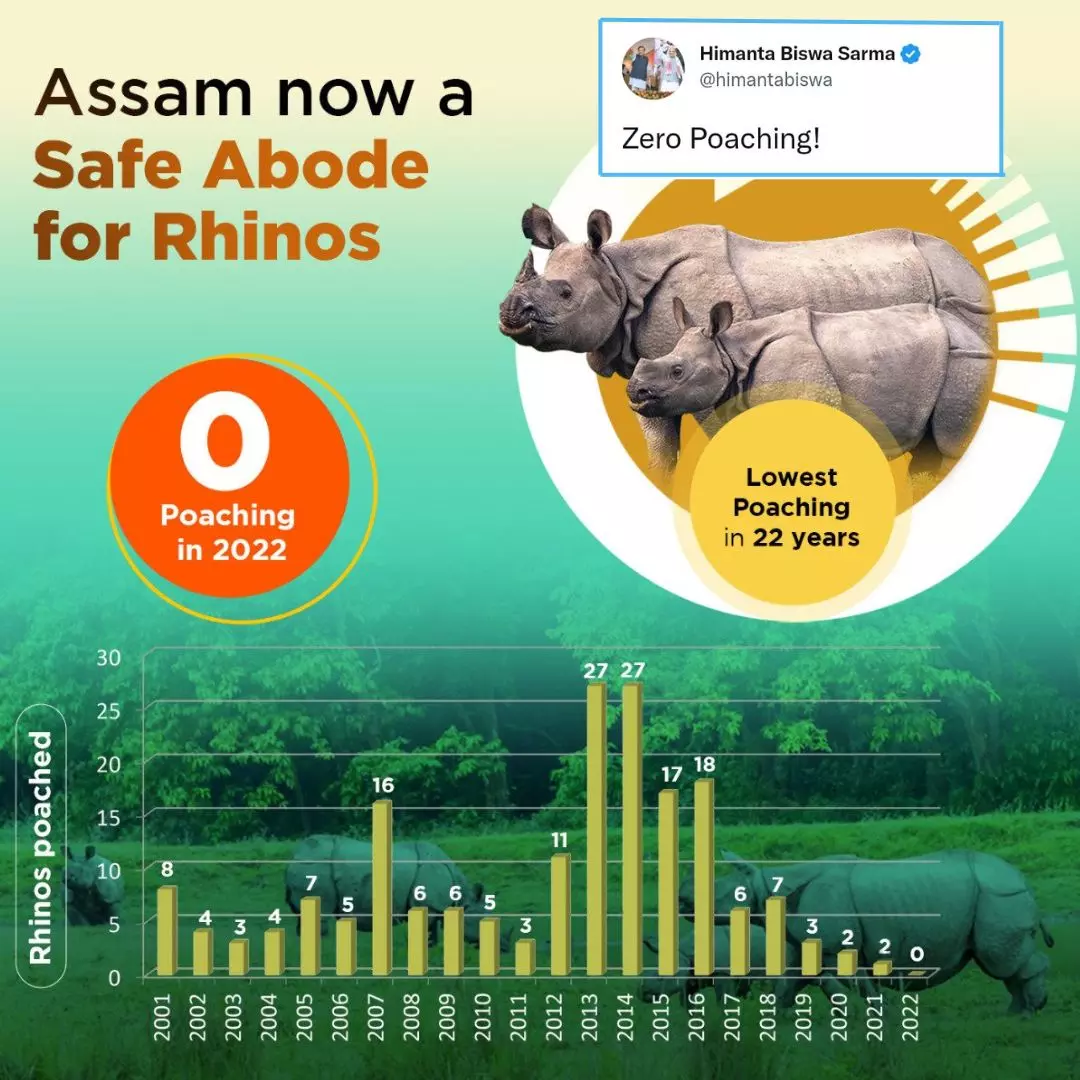
Image Credits: Twitter/Himanta Biswa
'Gentle Giant Much Safer Now!': Assam Records Zero Rhino Poaching In 2022; Lowest In Over 20 Years
Writer: Laxmi Mohan Kumar
She is an aspiring journalist in the process of learning and unlearning many things. Always up for discussions on everything from popular culture to politics.
Assam, 4 Jan 2023 10:16 AM GMT
Editor : Shiva Chaudhary |
A post-graduate in Journalism and Mass Communication with relevant skills, specialising in content editing & writing. I believe in the precise dissemination of information based on facts to the public.
Creatives : Laxmi Mohan Kumar
She is an aspiring journalist in the process of learning and unlearning many things. Always up for discussions on everything from popular culture to politics.
A year into establishing a special task force and modern technology to bring down poaching, Assam recorded zero poaching cases of the great Indian Rhino in 2022. Here's how the northeastern state adopted measures to protect the great one-horned animal.
The year 2022 ended with the good news that not a single one-horned rhino in Assam was poached. Celebrating the news, Chief Minister Himanta Biswa Sarma took to Twitter to convey that the poaching numbers were recorded to be the lowest in 22 years, with zero cases reported in 2022. The Twitter post by the Bharatiya Janata Party (BJP) leader read that "The gentle giant is now much safer in Assam."
The last poaching incident occurred on December 28, 2021, at Hilakunda, Kohora, in the Golaghat district. A blend of strict vigil by armed commandos, forest personnel, and modern technology is said to have helped the state achieve this target. The graph has been at a low for over two decades, and by 2022, the state could mark zero poaching incidents and a safer space for the great Indian Rhino.
Zero Poaching!
— Himanta Biswa Sarma (@himantabiswa) January 2, 2023
2022 was really special for our rhino conservation efforts. Not a single rhino being poached in 2022 & just 2 in 2021, the gentle giant is now much safer in Assam.
Kudos to @assamforest dept & @assampolice for their sincere efforts to protect the iconic animal. pic.twitter.com/mVIHsD0xFe
Protecting The One-Horned Herbivore
Rhino poaching had become a growing concern in the state. Around 2013-2014, the state witnessed at least 27 deaths, but the numbers have consistently been falling ever since. The state government, in a mission to bring down the numbers to zero, established a 22-member task force led by special director General of Police (law and order) GP Singh in 2021. The task force comprised senior forest officers and superintendents of Police (SP) of at least eleven districts and divisional forest officers of six wildlife divisions. The districts under the project included Golaghat, Nagaon, Karbi Anglong, Biswanath, Sonitpur, Darrang, Morigaon, Baksa, Chirang, Barpeta, and Majuli.
A report by the FirstPost cited Chief Wildlife Warden MK Yadava saying, "We have intelligence both from forest and police sources about activities and movements of poachers, which helps in action against them." Several measures were adopted, including tracking past poachers and their present activities, mapping all boatmen, surveillance through CCTVs (including night vision), and implementing a zero-tolerance policy. The Police also coordinated and sensitised people living in and around Nagaland, Arunachal Pradesh, and Manipur forests.
Zero Rhino Poaching cases in 2022.
— Assam Police (@assampolice) January 2, 2023
Our united efforts continue to bear fruits of safety for Rhinos.
Under the leadership of Hon'ble CM Shri @himantabiswa, #TeamAssam is dedicated to protecting Assam's Unicorns.@kaziranga_ @assamforest @DGPAssamPolice @gpsinghips @HardiSpeaks pic.twitter.com/9MB2Vq9Z1c
Apart from this, drones and dog squads were also deployed to keep an eye on the poachers. The 'K9 Unit' set up in 2011, was touted as India's first dog squad for wildlife crimes, and it has been effectively sniffing out hunters at national parks and wildlife sanctuaries. All the coordinated efforts finally proved fruitful in preventing poaching incidents, and the numbers have been brought down to zero.
According to media reports, four poachers have been killed since the task force was established, and 58 others were arrested. The forces also made it a point to address the floods that threatened their extinction and built high mud platforms for the animal to take refuge during the monsoon seasons. Celebrating the news, GP Singh also took to Twitter and stated, "We would strive to keep the graph flat."
গড়ৰ চিকাৰৰ বিৰূদ্ধে চলোৱা আমাৰ প্ৰয়াসে ভাল ফলাফল লাভ কৰিছে।।২০২২ চনৰ বিগত বৰ্ষত অসমত এটাও গড় চোৰাং চিকাৰীয়ে মাৰিব পৰা নাই।। শেষৰ তেনে ঘটনা ঘটিছিল ২৮ ডিচেম্বৰ,২০২১ ত গোলাঘাট জিলাৰ কহৰাৰ হিলকুণ্ডত।। চোৰাং চিকাৰৰ বিৰুদ্ধে আমাৰ প্ৰচেষ্টা অব্যাহত থাকিব @assampolice @CMOfficeAssam pic.twitter.com/nPCyNCr8oN
— GP Singh (@gpsinghips) January 2, 2023
Why Did The Need For Protecting The Rhinos Arise?
The Indian rhinoceros that inhabit the Brahmaputra valley, and some areas of North Bengal and southern Nepal, is the largest of the rhino species. Kaziranga National Park, located in Assam, is home to around 2,613 Rhinos, and the numbers have been increasing as per the latest census data published by the national park authority. The National Park, in the floodplains of the Brahmaputra river, is said to be the biggest habitat globally for the one-horned rhinos.
The International Union for Conservation of Nature Red List had earlier placed the animal in a vulnerable category. The conservation efforts undertaken ever since are said to be "among the greatest conservation success stories in Asia." Poaching is among the biggest threats to the great Indian rhinos due to the superstitious beliefs and market value attached to the animal. Even though there is no proven medical benefit, rhinos were being hunted for their horns to treat a host of illnesses. This belief was also predominantly seen in regions of China and Taiwan, where a high demand existed for rhino horns for the preparation of traditional medicines.
The Assam government, to convey a message to poachers that rhino horns don't carry any medicinal or monetary value, publicly burnt a stockpile of 2,479 horns. CM Biswa Sarma back then stated that "the use of rhinos' horns for medicinal purposes is a myth." Apart from these scientifically unproven beliefs, the loss of habitat was also one factor contributing to the dwindling figures of the massive Rhino. As many as 400 rhinos have died since 2018 due to devastating floods in Assam. The annual floods inundate Kaziranga and see the rhinos move uphill, making them even further vulnerable to poaching.
Also Read: Library On Trees! Here's How This NGO In Assam Is Reconnecting Students To Their Roots
 All section
All section














